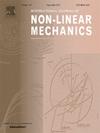On influence of channel geometry on evaporative convection at nonlinear distribution of surface tension of evaporating liquid
IF 2.8
3区 工程技术
Q2 MECHANICS
International Journal of Non-Linear Mechanics
Pub Date : 2025-04-24
DOI:10.1016/j.ijnonlinmec.2025.105121
引用次数: 0
Abstract
The characteristics of the joint flow of a two-component evaporative liquid and gas–vapor mixture in a narrow channel are under study. A two-sided mathematical model based on the equations of incompressible fluid flow is used for the analysis. The constructed exact solution is applied to investigate the influence of the thicknesses of lower layer on the flow characteristics. It is assumed that the surface tension of the evaporating liquid is a linear function of temperature and a quadratic function of the concentration of the evaporating component. Such a distribution of surface tension is inherent in ethanol-aqueous solutions.
The thickness of the liquid layer at which the mass rate of evaporation is maximized is determined. The distribution of temperature and concentration fields in the working segment is discussed. Changes in the lower layer thickness, where the mass rate of evaporation is maximal, are revealed for variations in the initial concentration of the liquid mixture. Issues related to choice of length of working area are addressed. Verification of the exact solution and the assumptions under which it is constructed is performed through a comparative analysis with experimental data.
蒸发液表面张力非线性分布下通道几何形状对蒸发对流的影响
研究了双组分蒸发液体和气-蒸汽混合物在窄通道内的联合流动特性。采用基于不可压缩流体流动方程的双边数学模型进行分析。利用构造的精确解研究了下层厚度对流动特性的影响。假设蒸发液的表面张力是温度的线性函数,是蒸发组分浓度的二次函数。这种表面张力分布在乙醇水溶液中是固有的。确定了质量蒸发速率达到最大的液体层的厚度。讨论了工作段温度场和浓度场的分布。下层厚度的变化,即质量蒸发速率最大的地方,揭示了液体混合物初始浓度的变化。讨论了与选择工作区域长度有关的问题。通过与实验数据的对比分析,验证了精确解及其构造的假设。
本文章由计算机程序翻译,如有差异,请以英文原文为准。
求助全文
约1分钟内获得全文
求助全文
来源期刊
CiteScore
5.50
自引率
9.40%
发文量
192
审稿时长
67 days
期刊介绍:
The International Journal of Non-Linear Mechanics provides a specific medium for dissemination of high-quality research results in the various areas of theoretical, applied, and experimental mechanics of solids, fluids, structures, and systems where the phenomena are inherently non-linear.
The journal brings together original results in non-linear problems in elasticity, plasticity, dynamics, vibrations, wave-propagation, rheology, fluid-structure interaction systems, stability, biomechanics, micro- and nano-structures, materials, metamaterials, and in other diverse areas.
Papers may be analytical, computational or experimental in nature. Treatments of non-linear differential equations wherein solutions and properties of solutions are emphasized but physical aspects are not adequately relevant, will not be considered for possible publication. Both deterministic and stochastic approaches are fostered. Contributions pertaining to both established and emerging fields are encouraged.

 求助内容:
求助内容: 应助结果提醒方式:
应助结果提醒方式:


